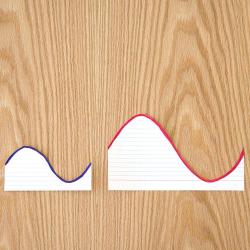Source Institutions
Source Institutions
Add to list Go to activity
Activity link broken? See if it's at the internet archive

By making models of light waves with paper, learners can understand why different colors appear in bubbles. Since light has different sizes, you'll see why certain iridescent colors appear in clear, thin films.
- 5 to 10 minutes
- 10 to 30 minutes
- 1 cent - $1 per student
- Ages 11 - 18
- Activity
- English
Quick Guide
Materials List (per student)
- Twenty-five 3 x 5 index cards “smaller cards” (approximately 76 x 127 millimeters; closest metric equivalent is A7)
- Seventeen 5 x 7 index cards “larger cards” (approximately 127 x 178 millimeters; between A6 and A5 in metric)
- Masking tape that is 1/2 in (1.25 cm) wide; the narrower the better
- Transparent tape
- Blue and red marker pens
- Scissors
- Pencil
- Optional: String
Subjects
-
Life Sciences
-
Human Senses and Perception
- Vision
-
Human Senses and Perception
-
Mathematics
- Representation
-
Physical Sciences
-
Vibration and Waves
- Diffraction and Interference
-
Light and Optics
- Reflection and Refraction
- Sunlight and Color
-
Vibration and Waves
-
The Nature of Science
-
The Scientific Process
- Formulating Explanations
-
The Scientific Process
Other
This resource is part of:
Access Rights:
- Free access
By:
Rights:
- Creative Commons: Non-commercial Share Alike (by-nc-sa), Exploratorium Teacher Institute,
